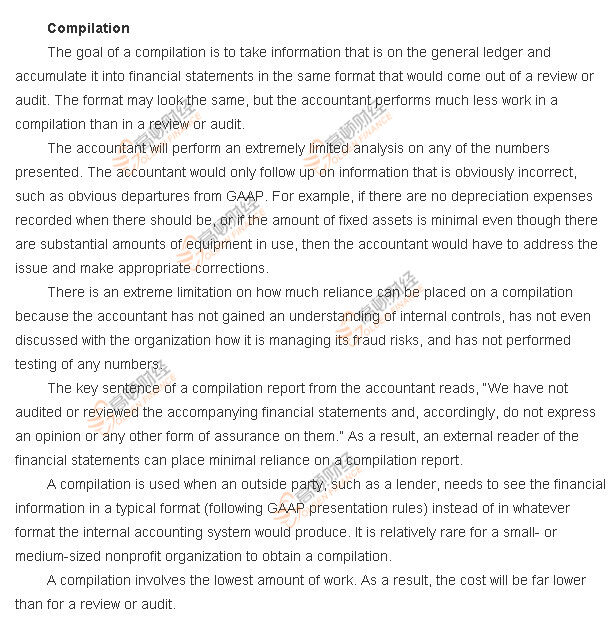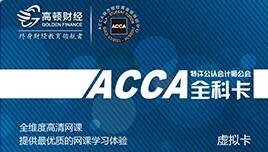高顿名师讲解2013年ACCA考试F8审计、审查、汇编之间的不同
高顿财经作为ACCA黄金级培训机构,始终坚持为ACCA学员提供丰富多彩的学习模式,包括普通的周末面授班级、短期突破提升的寒暑假集训班、个性化定制的一对一辅导课程和灵活便捷的远程教学课程,以及连续脱产学习的全日制培训课程。
同时,我们还为部分学员提供了更为细致和个性化的学习服务,丰富的课程购买组合,以及企业团购的优惠方案,同时满足在校、在职、个人、团体的不同培训需求。学员在我们这里,几乎可以在全年365天任何时间段选择以自己最为适合的方式进行ACCA的学习,大大提高了学习的便捷性。ACCA课程官网访问>>> .
ACCA2013年6月份考试时间已公布>>>6月3日-12日
高顿财经预测2013年12月份考试时间:12月2日-11日 12月考试时间官方消息我们将第一时间公布!敬请关注!点击收藏高顿财经
以下为高顿财经讲师讲解ACCA F8审计、审查、汇编之间的不同,高顿财经祝大家生活愉快,考试顺利!
The differences between an audit, a review, and a compilation
- Relevant to paper F8
There are three different levels of services you could obtain from a certified public accountant. These are referred to as compilation, review, and audit.
There is a common base for presenting financial statements, regardless of which level of service is used. This is a large body of rules that describe what information should be included in financial statements and the format for the information. This body of knowledge is called generally accepted accounting principles, or GAAP. Imperfect in implementation though it may be, the concept is that similar transactions will be recorded by all organizations in the same way. In addition, financial statements of similar organizations will actually look similar.

Review
The goal of a review is to provide limited assurance that financial statements do not have any known errors or departures from the accounting rules found in GAAP.
The procedures performed by the external accountant during a review will be limited to inquiries and analytical review. This means the accountant will ask many questions of management and the finance staff. If the answers to the questions indicate the accounting is appropriate, then no additional follow-up would be needed. Analytical review means the accountant will look at the relationships between numbers to make sure they make sense. For example, if attendance at a local church is up about 10% from a year ago, then the amount of contributions from the congregation should have increased by something in the range of 10%. If contributions increased by much more or less than 10%, the accountant would ask management why. Another example is that if the full-time staff of a ministry increased from three people to four people, then wages, payroll taxes, and other benefits should have increased by something in the range of one-third. The accountant will follow up with management on relationships in a financial statement that do not immediately make sense.
Normally, there will not be any testing of information in the financial statements beyond inquiry and analytical review. The accountant will not obtain an understanding of the internal control system and will not discuss how the organization is addressing the risk of fraud in the financial statements. As a result, there is a significant limit on how much reliance an external reader of the financial statements can place on the review report issued by the accountant.
The key sentence in a review report reads, “Based on our review, we are not aware of any material modifications that should be made to the accompanying financial statements in order for them to be in conformity with generally accepted accounting principles.”
A review is most often obtained when an outside party, such as a lender, needs to see the financial information in a typical format and is looking for some assurance that the information can be relied upon.
The cost of a review is obviously more than a compilation and might be somewhere in the range of 40% to 70% of the cost of an audit.
Audit
The goal of an audit is to provide reasonable, but not absolute, assurance that financial statements are fairly presented in accordance with GAAP.
In an audit, the accountant will gain an understanding of internal controls, evaluate the risk of major fraud, test those places where there is a significant risk of major fraud, and perform testing as considered necessary for the significant components of the financial statements. A few examples of the type of testing involved would be confirming the amounts on deposit in banks, testing the cost of equipment, confirming with donors the amount of recorded contributions, and reviewing the supporting documentation for a number of disbursements. There is a body of knowledge, called generally accepted auditing standards, that outlines the necessary work in an audit. The exact tests necessary are determined by the accountant based on his or her professional judgment.
An audit report provides more assurance to a reader of the financial statements than a review or compilation. The report provides reasonable assurance that, overall, the financial statements are fairly presented in all material respects. This does not mean they are exactly correct, but they do provide some assurance that there are no major errors. Since an audit could never test 高 of the transactions in an organization, there is a risk that untested transactions could be missing, mistaken, erroneous, or even fraudulent.
The key sentence in an audit report reads, “In our opinion, the financial statements referred to above present fairly, in all material respects, the financial position of [organization name] as of June 30, [year], and the changes in its net assets and its cash flows for the year then ended in conformity with U.S. generally accepted accounting principles.” As a result, the external reader of the financial statements can use the audit report to place reliance that the financial statements are fairly presented.
An audit is most often obtained because a lender requires it as a condition of making a loan. But in the nonprofit community, there are many reasons to get an audit beyond the requirement of a lender. Going through the audit process communicates a higher level of accountability. Many organizations voluntarily go through an audit because it subjects them to scrutiny by an outsider. Also, some voluntary membership organizations, such as the Evangelical Council for Financial Accountability, require an audit as a condition of membership. The ECFA allows members with income under $500,000 per year to alternate between audited and reviewed financial statements.
Organizations that give money to nonprofits often require an audit as a condition of making a grant. Federal funding over a certain threshold creates a requirement to go through the audit process.
The cost of an audit will be substantially higher than a review or compilation.
Prepared by Golden ACCA R&D Center
December, 2012

相关阅读
高顿名师解析2013年ACCA考试F5业绩管理知识点32013/02/18
高顿名师解析2013年ACCA考试F5业绩管理知识点22013/02/18
高顿名师解析2013年ACCA考试F5业绩管理知识点2013/02/18

















